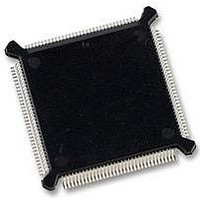MC68331CEH20 Freescale Semiconductor, MC68331CEH20 Datasheet - Page 62

MC68331CEH20
Manufacturer Part Number
MC68331CEH20
Description
IC MCU 32BIT 20MHZ 132-PQFP
Manufacturer
Freescale Semiconductor
Series
M683xxr
Specifications of MC68331CEH20
Core Processor
CPU32
Core Size
32-Bit
Speed
20MHz
Connectivity
EBI/EMI, SCI, SPI, UART/USART
Peripherals
POR, PWM, WDT
Number Of I /o
18
Program Memory Type
ROMless
Voltage - Supply (vcc/vdd)
4.5 V ~ 5.5 V
Oscillator Type
Internal
Operating Temperature
-40°C ~ 85°C
Package / Case
132-QFP
Controller Family/series
68K
No. Of I/o's
18
Cpu Speed
20MHz
No. Of Timers
1
Embedded Interface Type
QSPI, SCI, UART
No. Of Pwm Channels
2
Digital Ic Case Style
PQFP
Rohs Compliant
Yes
Processor Series
M683xx
Core
CPU32
Data Bus Width
32 bit
Data Ram Size
80 B
Interface Type
QSPI, SCI, UART
Maximum Clock Frequency
20 MHz
Number Of Programmable I/os
18
Number Of Timers
1
Maximum Operating Temperature
+ 85 C
Mounting Style
SMD/SMT
Minimum Operating Temperature
- 40 C
Cpu Family
68K/M683xx
Device Core
ColdFire
Device Core Size
32b
Frequency (max)
20MHz
Program Memory Size
Not Required
Total Internal Ram Size
80Byte
# I/os (max)
18
Number Of Timers - General Purpose
1
Instruction Set Architecture
RISC
Operating Temp Range
-40C to 85C
Operating Temperature Classification
Industrial
Mounting
Surface Mount
Pin Count
132
Package Type
PQFP
Lead Free Status / RoHS Status
Lead free / RoHS Compliant
Eeprom Size
-
Ram Size
-
Program Memory Size
-
Data Converters
-
Lead Free Status / Rohs Status
Details
Available stocks
Company
Part Number
Manufacturer
Quantity
Price
Company:
Part Number:
MC68331CEH20
Manufacturer:
Freescale Semiconductor
Quantity:
10 000
Part Number:
MC68331CEH20
Manufacturer:
FREESCLA
Quantity:
20 000
4
4.4.1.10 Halt Signal
4.4.1.11 Autovector Signal
4.4.2 Dynamic Bus Sizing
4-20
The internal bus monitor can generate the BERR signal for internal and internal-to-ex-
ternal transfers. An external bus master must provide its own BERR generation and
drive the BERR pin, because the internal BERR monitor has no information about
transfers initiated by an external bus master. Refer to 4.5.6 External Bus Arbitration
for more information.
The halt signal (HALT) can be asserted by an external device for debugging purposes
to cause single bus cycle operation or (in combination with BERR) a retry of a bus cy-
cle in error. The HALT signal affects external bus cycles only, so a program not requir-
ing the use of external bus may continue executing, unaffected by the HALT signal.
When the MCU completes a bus cycle with the HALT signal asserted, DATA[15:0] is
placed in the high-impedance state, and bus control signals are driven inactive; the ad-
dress, function code, size, and read/write signals remain in the same state. If HALT is
still asserted once bus mastership is returned to the MCU, the address, function code,
size, and read/write signals are again driven to their previous states. The MCU does
not service interrupt requests while it is halted. Refer to 4.5.5 Bus Exception Control
Cycles for further information.
The autovector signal AVEC can be used to terminate external interrupt acknowledge
cycles. Assertion of AVEC causes the CPU32 to generate vector numbers to locate an
interrupt handler routine. If it is continuously asserted, autovectors are generated for
all external interrupt requests. AVEC is ignored during all other bus cycles. Refer to
4.7 Interrupts for more information. AVEC for external interrupt requests can also be
supplied internally by chip-select logic. Refer to 4.8 Chip Selects for more information.
The autovector function is disabled when there is an external bus master. Refer to
4.5.6 External Bus Arbitration for more information.
The MCU dynamically interprets the port size of an addressed device during each bus
cycle, allowing operand transfers to or from 8-bit and 16-bit ports.
During an operand transfer cycle, an external device signals its port size and indicates
completion of the bus cycle to the MCU through the use of the DSACK inputs, as
shown in Table 4-12. Chip-select logic can generate data and size acknowledge sig-
nals for an external device. Refer to 4.8 Chip Selects for further information.
If the CPU is executing an instruction that reads a long-word operand from a 16-bit
port, the MCU latches the 16 bits of valid data and then runs another bus cycle to ob-
DSACK1
1
1
0
0
Freescale Semiconductor, Inc.
Table 4-12 Effect of DSACK Signals
For More Information On This Product,
DSACK0
SYSTEM INTEGRATION MODULE
1
0
1
0
Go to: www.freescale.com
Insert Wait States in Current Bus Cycle
Complete Cycle — Data Bus Port Size is 8 Bits
Complete Cycle — Data Bus Port Size is 16 Bits
Reserved
Result
USER’S MANUAL
MC68331











